This Washed Flour Seitan method makes great seitan that PULLS APART like chicken–with only water and flour!
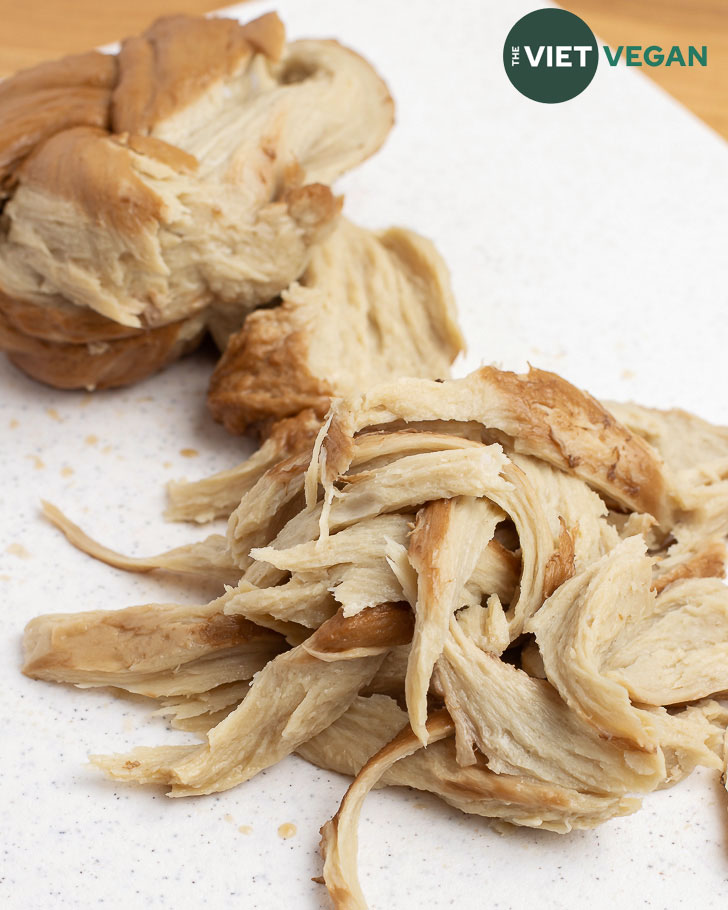
Washed flour seitan has been a type of seitan that I’ve been too intimidated to try making myself for a while. I had seen it for years and it’s some of the oldest methods of seitan making there is (tracing back to Buddhist Vietnamese and Chinese traditions of washing the starch out to create noodles and using the gluten mass as the protein for vegetarian meals).
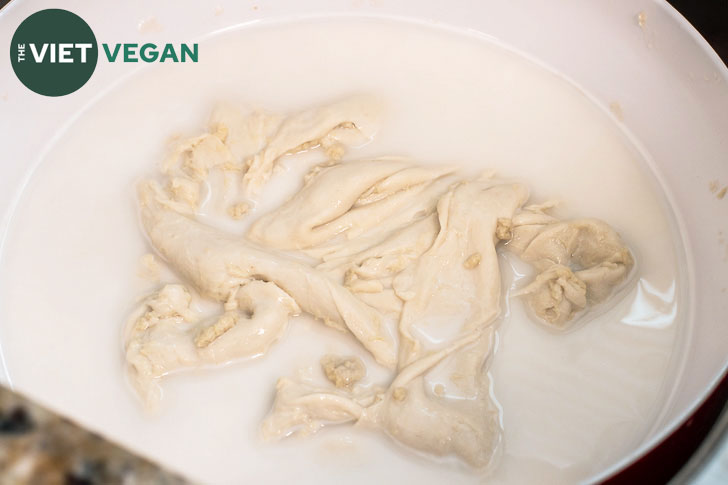
Washed Flour Method VS Vital Wheat Gluten
The difference between making the Washed Flour Method versus the more common method of using vital wheat gluten (or often listed at the bulk food store as gluten flour) is that the washed flour method removes a lot of that pungent, almost bitter gluten-flour flavour that seitan can often have.
The extra work it takes to wash the flour and the resting between certain steps can be time consuming, but I swear this is really fun and such a unique texture from any other vegan mock meat that you can buy!
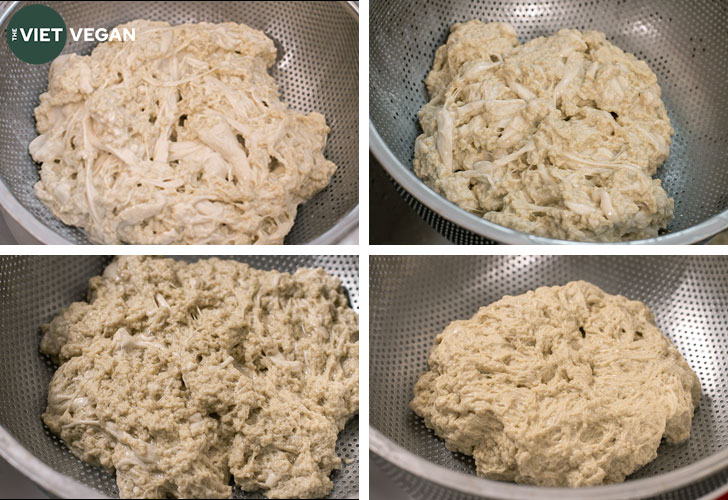
Washed Starch
Washing the starch out of this mass to reveal the gluten underneath is such an interesting process, and the different things you can make with the starch afterwards is really awesome! I’ll release the recipes for cold skin noodles and washed starch bacon once I perfect them.
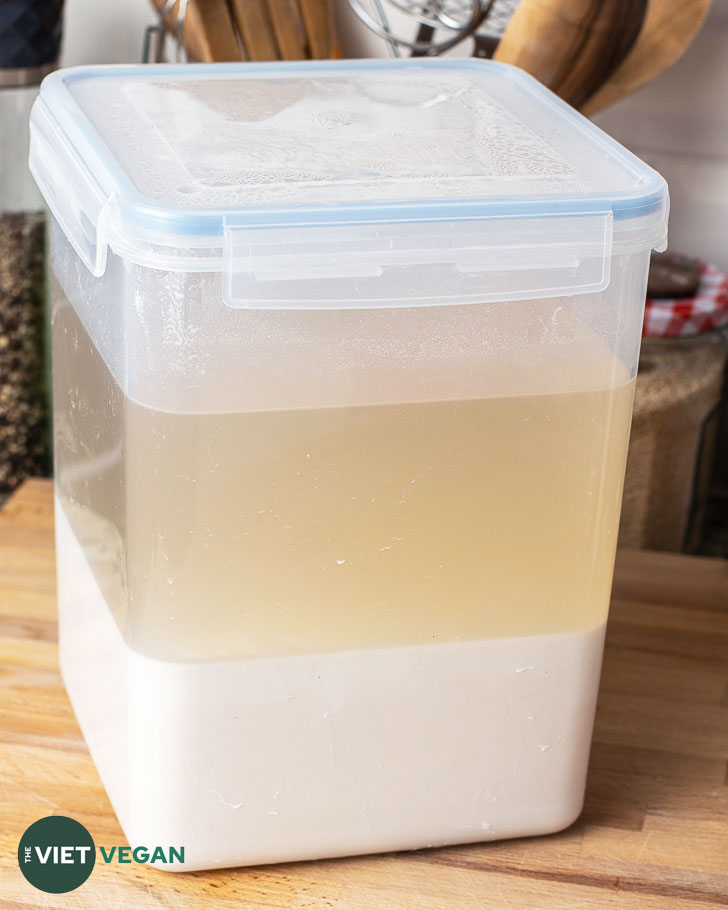
I keep my starch in the fridge in these large airtight containers and let it rest so that the starch will settle and the water will sit on top. You can pour off the excess water and cook with the liquid wheat starch!
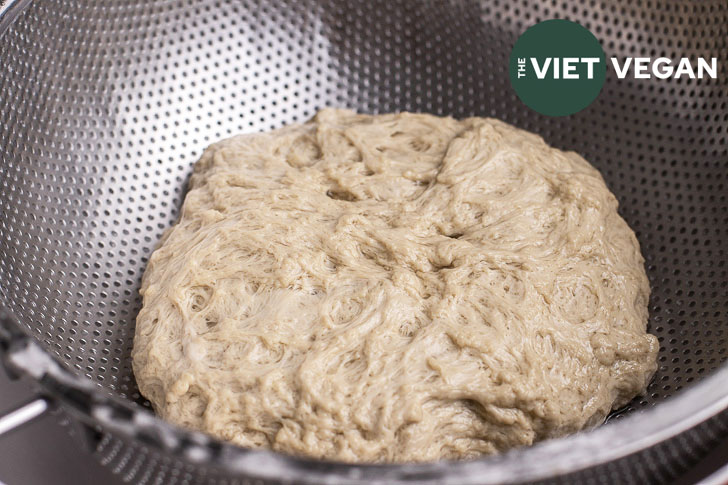
When I first tried this method, I didn’t wash out enough of the starch for the seitan to really bind together and get super stretchy. When in doubt, just keep washing out the starch, and you’ll get this really stretchy structure.
At this point, I’ve seen people throw this block of seitan into the food processor with spices, some broth paste or bouillon cubes, and tofu or beans, to break up the texture so the end result won’t be so rubbery.
The base seitan itself is fairly dense and chewy, but I really liked it! I think in the future I’ll play around with blending in different ingredients but the past few times I’ve made this, I’ve just been too lazy to bust out another appliance I have to clean haha.
Shaping the Seitan
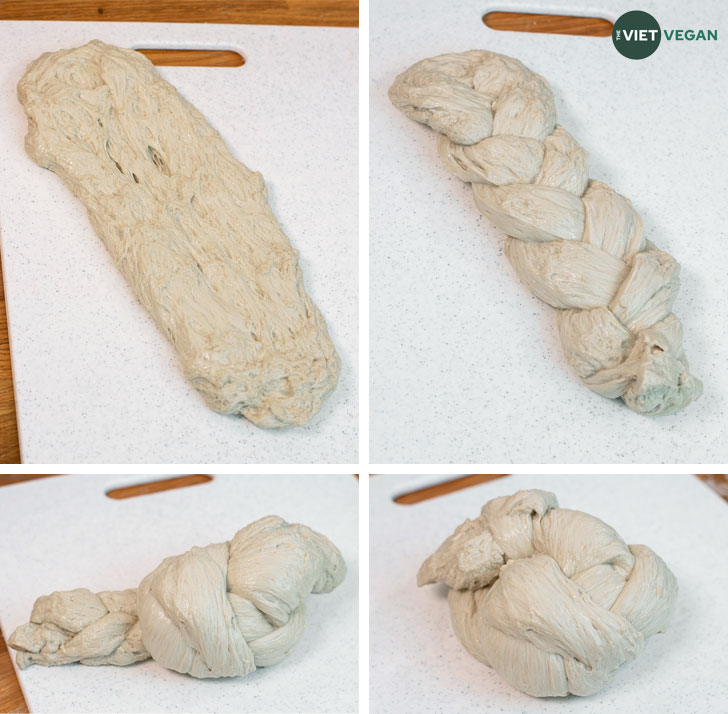
I ended up cutting the large long block into three strands and then braiding that. Once I had that thick braid, I pulled and stretched it to tie that into a large knot. The knotting process gives you that torn chicken-texture that is so useful for various recipes!
Cooking the Seitan
Now that the most labour intensive part is done, I cooked this in a beefy broth, but in retrospect it probably would have been better in a chicken-y flavoured broth (either the Better than Bouillon vegetarian chicken broth base or the Osem vegetarian chicken consommé would be great).
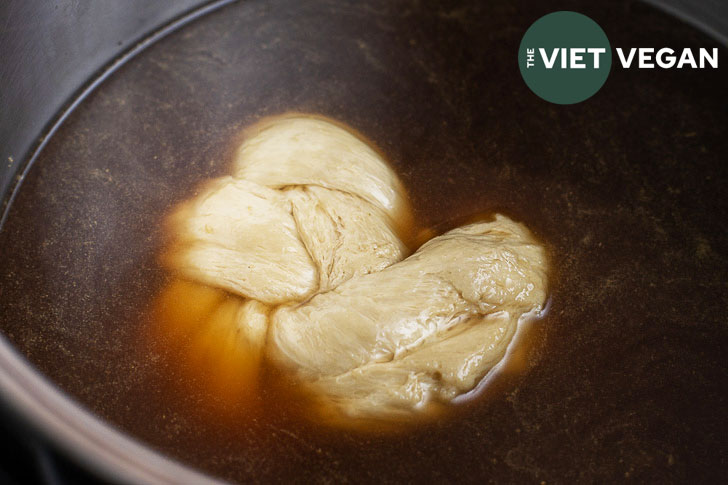
I simmered for two hours in my Instant Pot on the slow-cooker setting, but you can easily do this in a regular slow cooker or over a steady low simmer on the stove. Like when you cook regular seitan, you don’t want the broth to be bubbling at all, you’ll want the broth to be at simmering temperature.
Cranking up the heat too high or cooking too long will yield a really tough and rubbery texture, so I definitely would recommend using a slow cooker or your Instant pot for this.
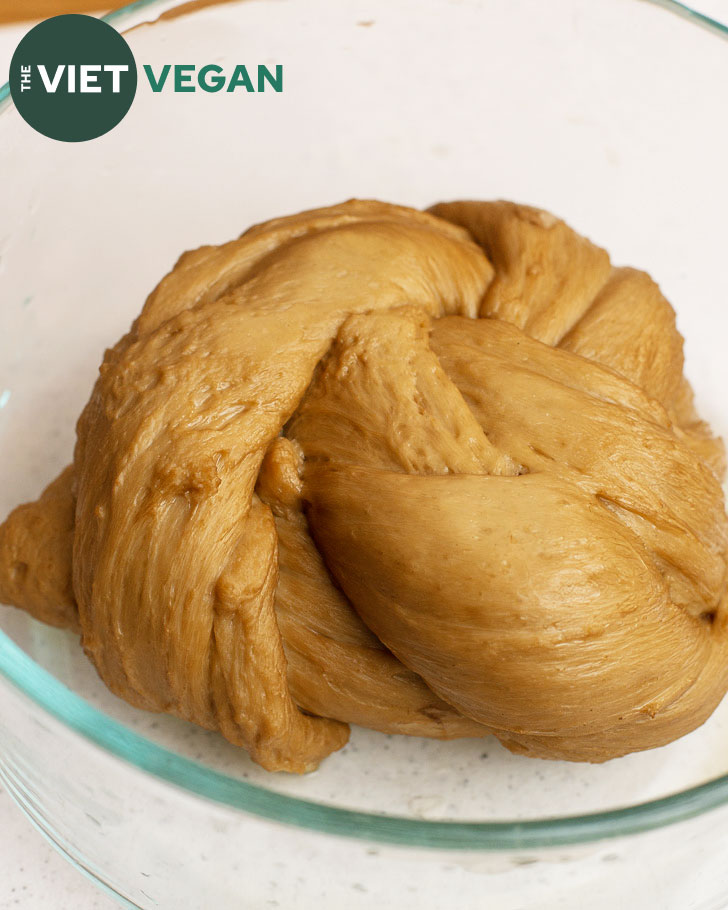
Once the seitan has simmered, you can eat it immediately, but the texture will be way more developed once you let it chill for at least 4-6 hours. I store it in the fridge in some broth so it doesn’t dry out.
The Final Step
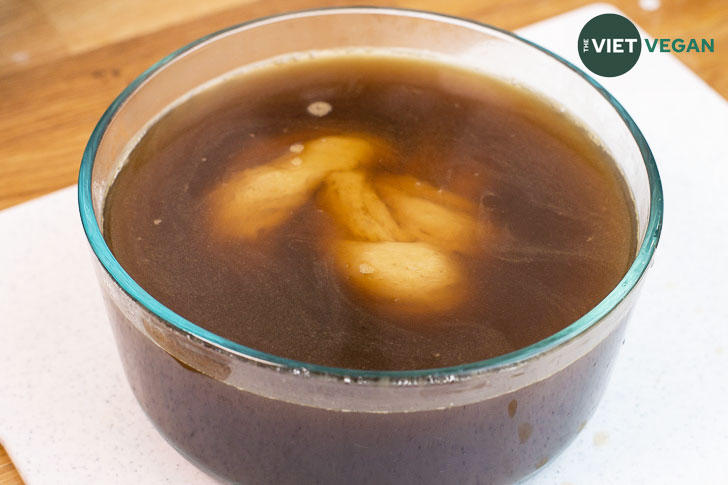
Once it’s been chilled and has had time to rest, you can pull it apart and get these incredible shreds! I’ve stored them in the fridge for a couple days and I’ve stored other seitan easily in the freezer for months at a time. I haven’t tried it with this particular seitan (we eat it too fast!), but since it’s basically the same as any other seitan, it would be just as good after freezing too.
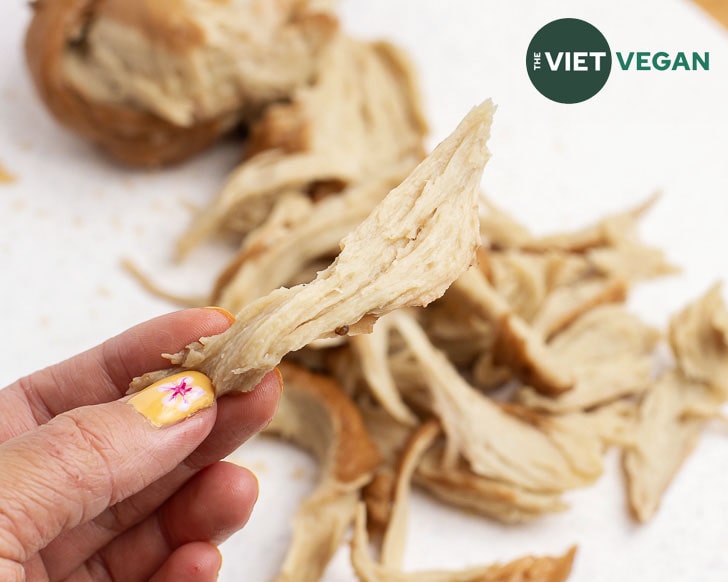
Resources:
I definitely did not come up with this method on my own! I had done a bunch of reading from various methods (two of the recipe files on the Seitan Appreciation Society FB group informed me of the general ingredient ratios) and the Seitan Society step-by-step photos helped me a lot with understanding the stages and what they looked like.
Washed Flour Seitan Method
Ingredients
- 1200 g all purpose flour** about 9 cups
- 750 mL water 3 cups
- 2 L vegan broth or enough to just cover the seitan in your slow cooker/pot
Instructions
Preparing the Initial Ball:
- In a large bowl, combine the flour and water and mix until you get a fairly shaggy ball.
- Turn out the mixture onto a clean counter and knead until you get a fairly smooth ball that springs back when you poke it. This should take about 10-15 minutes of kneading, but if you have a bread maker or a heavy-duty stand mixer, you can let that do the kneading!
- Cover the ball with cool water and allow to rest for 1-2 hours.
Washing the Flour:
- After a rest, pour out the water and cover the ball with fresh, cold water.
- Start kneading the dough in the water to wash out the starch. Once the water gets really opaque and thicker with starch, strain the seitan through a sieve and reserve the starchy water for other recipes (coming).
- Repeat the rinsing with a fresh batch of cold water and keep kneading until you get a spongey mass that clings together really well (refer to the 4 grid of the washed flour stages in the post). It took me 3-4 passes of kneading in fresh water, but just keep going until the water is only lightly cloudy instead of opaque and white.
- Squeeze out as much water as you can and then let the seitan rest in a sieve to drain for 20-30 minutes.
Prepping the Seitan to cook:
- Meanwhile, prepare your broth in Instant pot or slow cooker (or a pot with a low simmer). I used vegan beef broth paste, but you can use powdered broth or broth in a carton, whichever you like.
- After a rest, stretch your seitan until its about 12-15 inches long. Use a knife to cut 3 strands, leaving about 1 inch uncut at the top to hold together the braid. Braid the strands and then tuck in the ends into the braid.
- You can let rest again for about 5-10 min for better results, otherwise stretch out the braid to about 18-20 inches and then tie a large knot in the centre. Add on as many knots as you can on top and tuck in the ends inside the braid. I only really was able to knot it twice, but if I let it rest more, I probably could have added a third knot.
- Add the braided and knotted seitan into your broth and cover, set the lid to venting if you're using an Instant Pot, then simmer for 2 hours.
- Once cooked through, transfer to a container and cover with some of the broth. Allow to cool until cool enough to refrigerate, then let rest in the fridge for 4-8 hours.
Prep and Storage:
- After a chilled rest, pull apart to reveal the amazing shreds from this! Store in the fridge for up to 2-3 days, or freeze for up to a couple weeks!
- To cook, you can marinate this and pan-fry, or use just like you would shredded cooked chicken!




Avon Kleinman says
Hi.
What flour would you recommend using? High protein? Malted? All purpose?
Thanks.
Lisa Le says
Anything with over 10% protein content! I used all purpose flour, but bread flour, whole wheat flour, high protein flour would work.
Marc M says
Trying millet flour & organic unbleached white spelt flour [bothe high protein flours] but they are falling apart during the washing process?
Lisa Le says
Millet is gluten-free and therefore would just be washed out, while spelt should work (in theory?) since it is a flour that has gluten in it. You need a flour that has 11% or higher gluten content.
Mati says
I experienced the same with my spelt flour… but as you continue to wash it , the flour comes together better.
Christa Schwab says
Dear Lisa,
could you please recommend any sources about the history of using seitan?
I’m very interested in how long it has been around and where in the world itwas used.
Thank you!
Christa
Lisa Le says
Honestly Wikipedia looks like a good place to start! Their entry on Wheat gluten seems pretty detailed there :)
Sherri says
I know my mother made it back in 1975. It wasn’t called Seitan then. We called it gluten steak. The did not have any of what they have now. But she always used all purpose flour and the wash method was the only way back then. If there were other things then we didn’t know about it cause there was no internet then
Deanna Lenhardt says
Same. I grew up calling it “gluten”. My mom taught me to make it, when I was 12, but the braided technique is something I am eager to try. We would simmer for 1 hour, cool, slice (about 3/8”). and re-simmer for another hour. This makes it brown throughout, not just the outside of the roll.
Heena says
Hi Lisa! Thank you for sharing!! How does this compare to vital wheat protein seiten? I love the amount of protein that seiten provides, but don’t love the taste. Haha. Curious to try this and see if I can finally be a seiten lover! 🤞🏽
Lisa Le says
VWG seitan can be similar if you process it a certain way (like chickwheat style) but I don’t think I’ve seen any method that can do this same texture of pull-apart shreds other than that.
Lesley says
Hi Lisa, can you make “wings” out of the shreds? Dip them in batter or dredge in flour and fry or bake ? I’m going to try making this but I know my hubby is really missing his KFC style coated chicken
Lisa Le says
You definitely can! Honestly the texture of the shreds might be too dense for wings, before you knot and simmer, you could blend in like 1/4 cup beans, tofu, or some chickpea flour to break up the density, along with some seasonings (I would add like vegan chicken stock powder or mushroom broth powder) so that it has flavour in it. You could then sort of shape them into wing-sized pieces and simmer for about 30 minutes (since it’ll be smaller), or fry/simmer/fry method, or steam to cook, then dredge + fry if that makes sense. I might have to play around with a recipe later on but honestly I feel like making seitan with vital wheat gluten would be easier…This response is probably not helpful LOL
Liskarh says
A friend shppwed me a similar way to make seitan. When finished, we sliced it, breaded it, fried it up, made sauce to cover it with. Was delicious!
Deanna Lenhardt says
The great thing about Seitan is that it has NO taste, on its own. If you don’t like what you’ve tried, the culprit is the flavours used in your simmering brine, or breading meal spices used when frying it up afterwards.
Shelly S says
Thanks so much for this recipe! I have tried making it before but your details are what was missing. Im sure I will have better results next time.
zyle says
Hi, I’m very intrigued and would like yo try it. What are the macros? Do you think the calories decrease as you get rid of the starch?
Emily says
Do you have to let it refrigerate for 4-5 hours or can you just eat it hot?
Lisa Le says
The refrigeration helps the texture set up, it’s typically better to heat up again after it’s rested from the simmering process. You can eat it immediately if you like, but there’s a texture difference for sure
Ricardo Bohrer says
Great recipe! Any idea on its nutritional value? I’m already trying to fit it on my diet, but I’d need to know how much of the carbs are lost. I can’t seem to find this info anywhere!
Lisa Le says
It’s probably difficult to find out because it depends on how much one washes it out! If you wash it so it’s the same texture as mine, it’ll probably lost about 90% of the carbohydrate/starch content. The end result is fairly low carb.
Gail says
Carbs are washed away. After washing you’re left with a ball of protein. See YouTube video “Is Seitan Healthy”
Oliwer says
Hey.
Great recipe, but if i dont wanna wait after it simmering haha cannit be eaten there or do u recomend like a minimum time in the fridge? (2 hours maybe?)
Lisa Le says
You can eat it right after if you like, but the texture will set up better and be chewier after a 4-6 hour rest.
Fabiana says
Hi Lisa! I made it and mine came out very spongy, I cooked it for over 2 hours so I don’t understand why. I think it would be better to not store it in the fridge with the broth, cause it got really wet… but I don’t know, and I followed every step of the recipe
Lisa Le says
If it was really spongey, that typically means you either needed to braid it/stretch more or wash it a bit more. As you can see in the pictures for mine, I stored it in broth but when shredded, it was totally nice and chewy.
Sheila says
I have been making flour washed seitan or wheat meat as I call it, his since the year 1976. Typically it becomes spongy if cooked at a boil instead of a low simmer.
Anna Pearce says
Has anyone tried jumping from the washing stage to frying in small pieces (skipping boiling) then adding flavour after it’s cooked? I liked the washed flour chicken but it did remind me a little bit more like the soft underside of a roasted chicken rather than chewy fillet.
Lisa Le says
If you like a firmer texture, you might like the “fry simmer fry” method, where you sear one side, sear the other, simmer in shallow broth until it has reduced, then re-sear on both sides
Holly says
Thanks for the recipe Lisa. You mentioned you can use the starch water – what do you do with it?
Lisa Le says
I’ll be posting a liangpi noodle soon that uses the starch water :)
Susan S says
While I haven’t tried this recipe yet, I do know from experience that starch water is excellent for thickening sauces and gravies!
When I make pasta with tomato sauce, I always use some of the pasta water to thicken the sauce. I start with about a ladle-full or so, adding it to the tomato sauce as I heat and stir it. If it’s a large amount of sauce, or if it’s especially thin, I slowly add a little more at a time. The combination of heat and motion really get those starch molecules to hold onto each other, thickening the sauce in just a short amount of time.
You can save some of your starchy pasta water in the fridge for a few days. You can use it to thicken brown and white gravies if you don’t want to use dry flour or cornstarch. It will actually work better and faster because it’s already “wet”. (There’s a lot of science behind this.)
Happy experimenting!
Terry says
Hi Lisa, just made this and can’t wait to try it! I’m not vegan but thought this recipe was very interesting. Was wondering if you know the nutritional value/ calories per serving/grams?
Lisa Le says
I’m not too sure since it depends on how much of the starch you wash out! But I’d say the end result of seitan is fairly low carb and high protein, because you’ve mostly just got the gluten remaining.
Brenda says
Or you could just eat chicken :p
For reals, though, I’m intrigued. I made seiten once, and if I hadn’t managed to get my hands on some soy curls, I might have made it again, but it just felt like a lot of work for something that was just OK (although definitely preferable to tofu). This texture sounds more appealing, but we’ll see if I can talk myself into this much work for just a few servings…
BB says
What a weird, unhelpful, and passive aggressive comment, from start to finish.
Lisa Le says
Haha for context, Brenda is a veg-curious friend of mine from university. She meant no offense!
Cheryl says
Is there anything one can use the vegetable stock for after boiling the seitan? Can it be refused to boil another batch?
Lisa Le says
Of course! You could also use it for making gravy.
Meredith says
Hi Lisa!! :) Do you have any idea how we’d calculate the calories for your seitan? I’m curious how to incorporate this into my daily calories and record it into my calorie tracker. Thank you <3
Lisa Le says
Hi Meredith! I have no idea because it depends on how much starch you’re able to wash out of your mixture, but I believe the final product is like 70% gluten (so protein) at the very least, if that’s helpful?
Rachel says
You god damn bitch – I read this whole stupid page for the nutrition facts that were not there.
Lisa Le says
LMAO sorry, it absolutely depends on how much starch you wash out haha. I don’t really know how I’m supposed to calculate the nutrition for this XD
Lol Karen says
OMG, that comment from Lisa Le was the first thing that made me laugh all day, and it’s been a hell of a day. I really needed that. Can you imagine the entitlement that person must feel? How dare you not predict the desires of your readers in advance and fulfill them? /sarcasm. Thanks, Lisa Le. You really are something.
Lol Karen says
Sorry, I got confused. It was Rachel who said it. *you* are Lisa Le.
Andrea says
How do you know if you didn’t cook it well enough?
Lisa Le says
It’ll be soft/soggy and not firm
Erin says
Omg what a nice reply to such a mean comment. Thanks for providing this free recipe, take care of yourself!
MC says
They’re in the preview in Google somehow.
Stacy Neilson says
I recommend learning to skim an article to see if you need to read it in detail.
A good book to practice with is a classic by Dale Carnegie: “How to win friends and influence people”. Totally life changing.
Justina says
Ew “Rachel”, ew.
Mike Hillwig says
This was great!😅🤣😅
Jodie says
Rachel, What you said is not funny. Grow up and think about what your saying. Karma will find you that is the universal law.
Lisa thank you for putting in all the effort in this recipe.
Mary Marx says
Rachel, Google “macros for seitan” before you lash out at someone who has clearly done a late to prepare these instructions for us.
Marilyn Wolovick says
Hi. this looks amazing. Most recipes call for frying the sriram in oil. I try to avoid oil. Can it be cooked in broth and still taste as good? Thank you.
Lisa Le says
I typically cook it in broth without oil, so it should be fine! I do fry it as “chicken” pieces in oil but it’s not necessary
Hae says
Hi Lisa,
Would it be OK to refrigerate it overnight after I’ve combined the flour and water and kneaded it? I’ve covered it with water and am now waiting the two hours, but it’ll be rather late by the time it’s ready to wash out.
Thanks,
Hae
Lisa Le says
Yep that should be fine!
Bryce says
For those looking for nutritional content. Don’t get mad it all has to be calculated based in ingredients. this is how I did the math from nuritional content labels in my kitchen.
all purpose flour per 1/4 cup(30g)
110 calories
23g carbs
3g protein
~60% starch (based on searches)
pure starches potato/corn(what i had)
3.5 calories per gram
.85 carbs per gram
everything else 0
9 cups all purpose flour
3960 calories
828g carbs
108g protien
(9cups) x percentage of starch
(30g x 36) x .6 = 648g starch
648g starch is:
2,268 calories
550g carbs
wash out 90% of starches
homemade flour washes seitan is:
1,918.8 calories
333g carbs
108g protein
4 servings. per serving. (this actually seems to serve 5 in my house and recipes.)
479 Calories
83g carbs
27g protein
the starch content of flour greatly effects the calorie/carb result. I used the lower average of what i found of 60% but it varied between flours up to ~75%
Tal says
Thanks Bryce! Very helpful!
I’m not vegan but very curious on how it tastes and it seems easy enough to make.
Flexah says
Thank you for this Bryce,
You wrote 4 servings, but of how much.? I got around 520 grams of seitan. An I made 4 portions of around 4.2 oz each :)
I’m just trying to figure out the macros for this, since I write on myfitnesspal what I eat ^.^
david says
I am really sorry if this comes across as rude in any way, but I think your maths isn’t quite right.
starch *is* carbohydrate – the portion of carbohydrate that is not fibre or sugar (or simple carbohydrate) is starch.(or complex carbohydrate), so if you are washing out 90% of the starch you are going to have a lot less than 333g left over.
in the video she uses 1200g all-purpose flour, which is similar to strong plain flour here (which is what I use) – so I will calculate based on this – https://www.tesco.com/groceries/en-GB/products/254917932
1200g flour gives:
4176 kcal
20.4g fat
838.8g carbs
2.4g sugars
39.6g fibre
140g protein
to calculate the starch content, I subtracted the fibre and sugar from the total carbohydrate:
838.8 – (2.4+39.6) = 796.8g starch
if we assume as you said 90% of the starch is washed out:
90% of 796.8g = 717.12g
1g of carbohydrate has ~4kcal, so this is 2868.48kcal.
now subtract this from the total nutritional value of the flour, our new total is:
1307.52 kcal
121.68g carbs
140.4g protein
split into 4 would be around 327kcal, 30.5g carbs, 35g protein.
obviously as you said it depends on the type of flour, and how you cook it. I’m currently trying it with wholemeal flour which has more protein! again I’m sorry if this comes across as rude, I just hope it helps someone!
Sarah says
Hi Lisa thanks for sharing the recipe! I’ve got a batch on the go – just letting it rest before braiding and knotting. Although I’m sure I’ll find out shortly, should the cooking time be changed depending on batch size? Example, I only used 1/3 of the flour since I wanted to make a smaller batch. Similarly, would it require a longer cook time if I were to use more than 9 cups of flour? Thanks!
Lisa Le says
Hmmmm yes I think for smaller sizes you could probably reduce to a 1 hour simmer for a smaller amount! You’ll notice when it’s cooked through because it won’t be soft and gelatinous if you poke it, it’ll kinda bounce back more :)
Therese says
Hi Lisa. I’ve just done mine. I’ve used 3 cups of flour to 1 cup of water. Cooking in a slow cooker and reduced the cooking time to 2.5 hrs. However, it’s not brown. It still looks whitish. I’m currently cooling it before i can refrigerate for 4 hrs. Should i be cooking it longer until it becomes brown?
Therese says
I mean cookingbtime for 1.5 hrs instead of 2
Lisa Le says
Hi Therese! My seitan was brown because of my broth. If yours is whitish, that’s totally normal, you can use a darker/deeper broth next time if you like the brown colour. You can season it with different sauces, but the colour shouldn’t impact the result!
taylor says
what happens if my dough does not spring back up when making the initial ball. it springs up a little but not all the way. would i need to knead it more? is over kneading a thing?
Lisa Le says
I don’t think it’ll spring back all the way, it’ll still leave a dent! You just want some of the spring back so you know the gluten is developed but it won’t bounce back completely
Yahni says
Thanks for this! I’ve been looking for a recipe for the washed flour seitan method for a few weeks and I finally came across this. I can’t wait to try it out and I reckon I’ll definitely check out some of your other stuff!
Annie says
About how long does the washing process take?
Lisa Le says
It takes me about 15-20 minutes :)
Mary Charlotte says
Wow, this worked really well for me and I’m looking forward to playing with the spices next time! I tried to make bacon with the leftover starch water, but it turned out kinda gummy. I can’t wait till you release a recipe for that so I can give it another go.
Mel says
Hi Lisa
Recipe looks amazing, I was wondering if you could add some flavourings to the dough after it’s had its final rinse before shaping or would this not work? Thanks
Lisa Le says
Hi Mel! I’ve been experimenting on the side with blending in some dry spices and chickpea flour before knotting and cooking. You would do it before Step 2 of Prepping the Seitan to cook. I haven’t found a combo that I really love yet, but they’ve been pretty tasty experiments so far! Some suggestions: garlic powder, onion powder, white pepper, chili flakes, jerk seasoning, or even some boullion paste/consomme powder. You want to keep the liquid addition very low though, adding too much liquid to the dough will impact the integrity of the seitan sticking to itself.
Alice Nordlander says
I am attempting to cook this right now, but realized it won’t be finished until very late. Can you store the seitan in the broth over night, or is the maximum time 6 hours?
Lisa Le says
Yep its at least 6 hours, I have it rest overnight all the time :)
Julie says
Hi! I have a facebook group about this method. Would you be comfortable with me linking to this post, as I think you have explained it so wonderfully, especially for beginners?
Keep up the good work!
Lisa Le says
I would be honoured!
Dinah says
I may have missed this but how long do you cook it in a slow cooker. I don’t have an Insta Pot. But you mentioned that a slow cooker could be used. Do you cook it on low? For how long?
Lisa Le says
I used the slow cooker function on Instant Pot, so it’d be the same in a slow cooker. 2 hours on low :)
Matthew says
Hello, I am using a “newer” instantpot, I have it on slow cook-low-2 hours- vent. It is perpetually stuck on preheat, is this correct? I guess I’ll let it run for the 2 hours and see what the end product looks like. Thanks!
Lisa Le says
Hmmmm I don’t know! I’ve never seen that error. I hope it worked out?
Jessica Cohen says
I am on WW and vegetarian. Do you know the nutritional information for this recipie?
Lisa Le says
Someone estimated it in the comments, it’s hard to gauge precisely because it depends on how much starch you’re able to wash out.
Erica says
Hi ! I was wondering whether you can still use wheat gluten flour with this method ??
Lisa Le says
Wheat gluten flour is already washed of all of its starch. I’ve seen some people add gluten flour to the ball (with more water) and then wash it with the rest of the ball because it helps wash out that gluten-flavour a bit more, but I haven’t tried it myself.
nk says
Thanks so much for this Lisa!!! I’ve made this twice this week because it’s so good! Your videos are so thorough and fun to follow along :) Will attempt some noodles with all the starch sitting in the fridge tomorrow!
Stephanie says
What happens if the ball rests in cold water for more than 2 hours?
Lisa Le says
It’s fine! You could let it rest overnight if you wanted to, it’s just will add a lot more time to your total process.
Erin McAfee says
Hey, I tried to follow this recipe step by step. While washing I felt like I couldn’t get all the starch out and my seitn just became in small pieces and did stick together. So now I only have this handful amount. Maybe it was the type flour I used? ?
Erin McAfee says
Didn’t stick together ***
Lisa Le says
Before the gluten rebinds itself, it’ll fall apart for sure. When in doubt, keep washing and eventually enough starch will come out that the gluten will rebind when you squish the pieces together.
Adrien says
Honestly I’m seriously struggling with this recipe. Maybe I messed up somewhere along the way, but that braid just did not look like the video even after I rinsed way way more than 4 times. I’m still looking forward to the end result of this but it does not resemble the recipe in any way at this point (I just put the seitan with broth in the fridge). I’m going to try again after this and see if I can make it work a bit better, but I do want to warn anyone who’s not up for a difficult recipe to maybe try something else on this blog first (lots of great stuff that is much more self-explanatory).
Lisa Le says
Sometimes the best way to tell if you rinsed enough is based on how clear or opaque the water is. Sorry you had such a hard time with this recipe! How did it end up?
Paulina says
How long should I cook it on the slow cooker?
Lisa Le says
2 hours on low! :)
Mimzy says
Can you use bread flour rather than all purpose…?
Lisa Le says
Yep! Anything that has over 11% protein, bread flour is higher in protein and actually would work better here :D
Phil Covitz says
Is braising the only way to cook the gluten once it’s knotted and braided? Can it be steamed or roasted instead? Mine came out quite spongy and soaked up a lot of broth; I was hoping for something a bit drier.
Lisa Le says
If it was quite spongey, that might be due to the starch absorbing the liquid (which generally means you needed to wash it more). A lot of folks will wrap in foil and steam (so it doesn’t expand and absorb too much moisture), or they’re do the “fry, simmer, fry” method instead so it doesn’t quite act so much like a sponge. Hope that helps!
Please advise says
This is interesting because I read that it can be used as a Tofu replacer thus what would I need to do different to get a soft, medium, Firm Tofu like consistencies. I love the idea of washing for a milder flavor and then using the left over starch for other food items and lowering food costs by getting more out of what I am making.
I know nothing about Seitan. I only just learned of it because I am looking for Tofu replacements.
I feel it would help a coconut cream pie set up, could be used as an dairy free ice cream base, cream cheese alternatives, and lots more. I know that I will want mild flavor so omit all the broth. It’s the cooking times that will be changing probably less time needed yet others have said that there’s was sponge thus how do I turn sponge texture to creamy would adding coconut butter to the gluten before cooking help?
Thank you for your time and advice,
M. H.
Kat says
I saw you were looking for tofu replacements. Pinterest has great recipes for chickpea tofu, red lentil tufo and vegan lentil loaf. The chickpea tofu has a mild flavor. These are as firm or soft as you decide to make them.
Esti says
One of the best seitan I ever made, thank you!
Alisha says
Hi Lisa, can i know how much servings can this recipe provided ?
Lisa Le says
Serving/yield information is in the top left of the recipe card :)
Strawberry says
Hi Lisa! I attempted to make this and everting went well up until the cooking part. The ball of flour washed out nicely and I was left with a very stretchy chunk of gluten. However, when I cooked it, it became super spongey with a lot of what looked like air pockets. What am I doing wrong? :(
Lisa Le says
Hmmm maybe you were cooking at too high a temperature? That texture happens if it cooks too fast.
Carrie Xie says
Thank you Lisa! I clearly did not read the recipe properly and was cooking it at a steady boil! I will try again but with a simmer this time !
p.s. the sponge still fried up nicely and stayed rather crispy even though it was soak in a gochujang sauce!
Kimi says
Thank you for this recipe!! I have always wondered how the nuns at my temple prepare their “chicken”… I’m so excited to try it for myself!
Maria says
Hi!
I’m looking for an update on the recipe using the starch water.
Love your blog!
Lisa Le says
Hi Maria! Sorry, I should have linked it in the post! I posted these wheat starch noodles a little bit later :)
Sheena says
How much seitan did your 1.2kg of flour yield? Im guessing like 200-300 grams?
sav says
Hi,
I followed the directions to a T, however, I’m not sure what went wrong. I first put it in the instant pot on low for 2 hours and it was still a soggy mess. So, I put it in for 1 1/2 hours on high and then it expanded a lot. I thought I was sure to wash it a lot. (took me 7-8 passes) but any ideas? :(
Lisa Le says
If you cook it on high, it will definitely go spongey. If it a soggy mess, I’m afraid you probably didn’t wash out enough starch? How clear was the water once you were done your 8 passes?
Amber says
Hi. Thank you for this recipe. I am so excited to try it! I wanted to ask you – in addition to the flavor variations of this recipe vs. using the vital wheat gluten is there much of a cost difference? I don’t see how much seitan or how many servings are yielded in this recipe and was just wondering if you had any ball park guesses related to this topic. Vital gluten is quite expensive but flour is not… however 9 cups is quite a bit…
Anyways thank you for sharing this is awesome!
Lisa Le says
I’m not sure! I’ve never calculated it myself, but I feel like AP flour is cheaper, plus you can use the wheat starch you wash out so it’s not necessarily wasted.
Rosie says
hi Lisa, I don’t have an instant pot or slow cooker. You mentioned I can do it over a steady low simmer on the stove. May I know how long should I simmer it in a regular pot?
Lisa Le says
It should be the same amount of time: 2 hours :)
Roxanne says
Hi, I’m going to try this today. How long do you cook it in the slow cooker and at low or high heat?
Lisa Le says
I assume you’d use the same length as I would on the Instant pot (since i used the slow cooker setting). I think at low heat is best!
Rachna says
Hi, could this work with gluten free flour that contains rice flour, tapioca and corn flour? Thanks :)
Lisa Le says
Unfortunately not. The vital component in this recipe is gluten.
John says
If I mix it with some spices, soy, onion, garlic, olive oil etc and wrap it in grease proof paper and foil can I roast it?
Lisa Le says
Unfortunately if you do that, you’ll get a v dense and chewy bread. You can place in a broth and bake in the oven to simmer?
Sal says
What to do with all that leftover water (in a drought) ?
Add a little sugar and lemon juice and your favorite liquor. Tequila?
Delicious.
Try making easy noodles. Oil dish, pour 1/3 cup of starch, microwave 30 sec, cool, then cut. This works with rice flour, so I am only assuming
Polk says
Mine broke into pieces small enough to escape the colander and go down the drain. After 7 washes, I only have a palmful of dregs left. It felts like holding pated pet food. The water was never transparent.
I used all-purpose flour that had 3g proteins and 26g carbs per serving, that should be 11.5%.
I used a kitchenaid at speed two for 5 minutes, which should have been the equivalent of 25 minutes of kneading.
What did I do wrong here?
Lisa Le says
Hi there! It sounds like there wasn’t enough gluten (protein) in the dough or enough gluten formation to hold everything together unfortunately. How long did you let it rest?
Kameleon says
Thank you for this video, I am going to try and make this!!
Maybe I’ve missed the information but I’m wondering; How many people does this amount of seitan serve?
I need to make a bunch for a party this weekend :)
Lisa Le says
It makes 4 servings haha… Some people try to make it more work it by adding vital wheat gluten to the flour so that the yield in the end is more, and the washing helps wash the specific gluteny flavour that you would normally get with just VWG seitan.
Jackie says
I followed the directions. I let it rest after draining it but I couldn’t get the ball to knot. When I stretched it out and tried to knot, it just broke apart into strands. Any suggestions?
Lisa Le says
I think when this happens, there is still more starch in between the gluten that keep it from binding together. Keep rinsing!
Basil Storey says
I only had self raising flour on hand so I used that and it worked perfectly. Amazing recipe, very tasty!
Katherine Brown says
I wish I had watched the video to start but I’m a major baker and just do recipes verbatim. The type of colander is critical, I used a pasta colander and as it turns out a sieve would have been better. I lost about 5 cups of content down the drain.
Lisa Le says
Ah so sorry about that! I will amend my recipe to be more clear.
Evan says
Just tried this recipe. Any tips for if the water comes up opaque every single time? I was using all-purpose flour and passing through a sieve each time. I got to my 11th wash and called it because it wasn’t looking like the photos at the top and it kept coming up murky. I called it and went on to the rest of the recipe but I couldn’t braid it because it was so soggy. Not sure what else I should or could have done. Any advice?
Lisa Le says
If the water is still opaque, that means there’s still more starch in your gluten ball. Keep washing! Also don’t be afraid to keep washing in the opaque water until it’s like really really milky. The starch will still come out.
Lyric B. says
this recipe is really great, but its so crazy that it didnt include any seasonings or even salt!!!!! braising wasnt really enough for imparting flavors deep into the seitan loaf, salt needed to go in before step one.
Jenny says
I just tried this but it ended up during the washing just like a big gloopy blob of lumpy clay :(
Did I knead wrong?
The water is still super cloudy after about 8 washes, but I had to give up because I couldn’t even rinse it because it just clogged up the sieve in a big gloop.
I really want to try again! What did I do wrong?!
Lisa Le says
If you watch the video around the 5 min mark, you see that I get that gloopy lumpy blob. You gotta keep washing!
Erik says
Thanks so much for this recipe! I’ve made seitan a couple of times before, each time using a different method.
This is my first time making it in a slow cooker. I used 9 cups of refined high-gluten pizza flour and washed it until the water was basically clear (to reduce as much starch as possible). I ended up with a large grapefruit-sized ball.
I did save my first wash water (washing until the water was the color of thick white paint) to decant, dry, and pulverize into powder for storage. I’ll be using this for making glazes and for thickening sauces and gravies.
I stretched out the dough ball and used your braiding method, but I opted not to do the final ‘knotted ball’ step. I figured the broth would more easily penetrate the braid if it wasn’t balled up. However, I’m now wondering if it’s going to fall apart. I suppose it won’t matter if it does, since I’ll be shredding it anyhow.
It’s currently simmering on low in my electric crock pot. I figure it will need to cook longer since it’s on low, but hopefully, this should give me better texture and allow my leftover homemade corned beef boiling broth (beef brisket, onions, cabbage, potatoes, carrots, onions, salt, garlic, black/red pepper, and sweet spices) to penetrate deeper into the strands.
Erik says
As a follow-up, the seitan turned out great. It didn’t fall apart with only braiding and not making the final ball knot. The broth I used wasn’t the best choice for this, although it still tasted good. Since I washed out almost all of the starch, I’m guessing that the broth couldn’t penetrate as deeply, due to the sietan being more dense and less spongy.
The texture was a little rubbery, as expected, but not as bad as I thought it may be. I could have shredded it with a fork, but slicing it thin and stir-frying with veggies worked so well, I couldn’t be bothered to do it.
The next time I make this, I’ll use a darker and much more concentrated broth with a higher salt content. Miso, soy sauce, ginger, star anise, red pepper, garlic, cinnamon, cloves, and rice wine. Tthe alcohol in the wine should help give a slightly softer texture and will be boiled off during simmering. I’ll also try slicing the braid into chunks before simmering, to promote deeper broth penetration.
I’ll also test mixing into the dry flour, a little baking soda to help relax the protein fibers, and a little salt to help strengthen and elasticize the protein strands. Hopefully, these additions will give a softer texture.
Erica says
Thank you so much for the recipe! Just a question, how do you think it would be stored best in the freezer? After it has been shredded or in broth?
Thank you!
Lisa Le says
After it’s shredded, with a bit of broth!
Nick says
Hello, I had a question about this process. I followed your steps up until braiding the seitan. After washing it several times, I let it rest and drain for 30 minutes but when I went to braid it, the whole thing basically fell apart. It was sticking to everything and I literally could pick up the pieces to braid it. Any idea what I did wrong? Did I knead it too much when I was washing it?
Thank you for the recipe and any help you can offer.
Lisa Le says
Hmm I wonder if you maybe needed to wash out more starch?
Lauren says
You can freeze shreds for months not weeks :)
Rachael Terry says
Can I make ” steaks” out of some of the mixture, rather than shredding it all?
Lisa Le says
Absolutely!
Rossella says
Hi Lisa, thanks for this recipe, it came out really nice :) I was wondering, have you ever freeze it? does it freeze it well in your opinion and if it does at which stage should I do it, i.e. before shredding or after? Thank you!
Lisa Le says
Yep! I freeze it after shredding :)